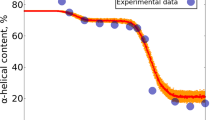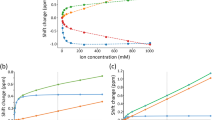Abstract
IT is thought that the tertiary structure of a globular protein in aqueous solution is quite largely conditioned by the interactions between the amino-acid residues and water. In general, the expected result is a folding of the polypeptide chain(s) such that the charged residues are at the surface of the molecule while the uncharged residues are packed in the central regions of the molecule. The structure is stabilized by hydrophobic interactions and intra-chain hydrogen bonding in the interior, and at the surface by hydrogen bonding with water1. The ability of this theory to account for the behaviour of some globular proteins has led to attempts to derive relationships between composition and structure that may have predictive value. Two examples are Fisher's “law”2 and Hatch's3 polar ratio. In 1908, proteins were classified by British and American committees according to their solubility4; there may therefore be a relation between this classification and the predictions obtained by applying the suggestions of Fisher and Hatch. Grlutenin and gliadin, the exemplars of two of the nine solubility classes of simple proteins, were used in an attempt to predict their properties in solution from their amino-acid composition.
This is a preview of subscription content, access via your institution
Access options
Subscribe to this journal
Receive 51 print issues and online access
$199.00 per year
only $3.90 per issue
Buy this article
- Purchase on Springer Link
- Instant access to full article PDF
Prices may be subject to local taxes which are calculated during checkout
Similar content being viewed by others
References
Tanford, C., J. Amer. Chem. Soc., 84, 4240 (1962).
Fisher, H. F., Proc. U.S. Nat. Acad. Sci., 51, 1285 (1964).
Hatch, F. T., Nature, 206, 777 (1965).
Anon., J. Physiol., 37, 32 (1908); Amer. J. Physiol., 21, xxvii (1908).
Wu, Y. V., and Dimler, R. J., Arch. Biochem. Biophys., 103, 310 (1963).
Jones, R. W., Babcock, G. E., Taylor, N. W., and Senti, F. R., Arch. Biochem. Biophys., 94, 483 (1961).
Winzor, D. J., Biochem. Biophys. Acta, 74, 144 (1963).
Taylor, N. W., and Cluskey, J. E., Arch. Biochem. Biophys., 97, 399 (1962).
Nemethy, G., and Scheraga, H. A., J. Phys. Chem., 66, 30 (1962).
Author information
Authors and Affiliations
Rights and permissions
About this article
Cite this article
TRACEY, M. Solubility-composition Relations of Gluten Proteins. Nature 211, 850–851 (1966). https://doi.org/10.1038/211850a0
Issue Date:
DOI: https://doi.org/10.1038/211850a0
Comments
By submitting a comment you agree to abide by our Terms and Community Guidelines. If you find something abusive or that does not comply with our terms or guidelines please flag it as inappropriate.



